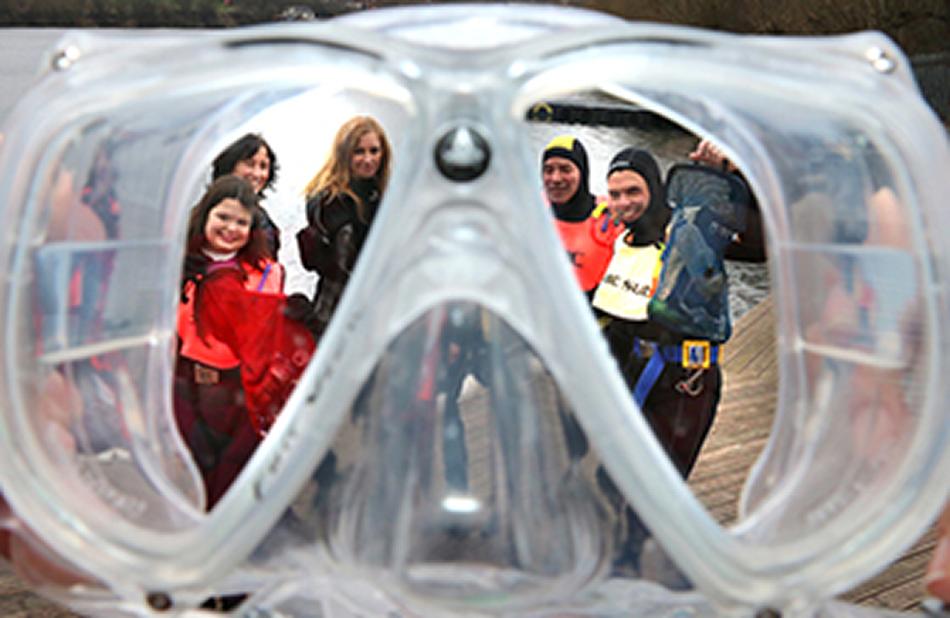
Image courtesy Tim Allsop
When visibility disappoints, consider the possibilities that snorkelling holds for wildlife encounters just above the water line. Andy Torbet explains.
Life is abundant below the surface. From rivers to rock pools and seashores to lakeshores, there’s plenty to see. I’ve covered our marine and freshwater wildlife from many angles in my time. But one angle that has had little attention is looking up... and out.
As snorkellers, we show little profile above the surface. It’s not something we think about in the normal course of a snorkelling trip. However, looking up can prove a huge advantage if the wildlife encounter we’re seeking is not underwater. I have drifted past riverbanks and rocky outcrops with little more than the top half of my head showing. It’s the same principle as a crocodile at the surface... but I’m just watching, not snacking. Naturally we wear hoods, which are typically black. This only adds to the effectiveness of our camouflage, as the lack of contrast is much less likely to attract the attention of animals on the shore. Our masks help by getting us lower in the water, while also shielding our eyes and so making us even less threatening.
Try to minimise how much of you is above the surface, keep low and as vertical as possible to ensure most of your body is hidden beneath the surface
When snorkelling with seals, it’s sometimes possible to view their bobbing heads out of the water, but please don’t approach a seal that has hauled out, as it’s chosen to be there for a reason – it needs to rest and warm up. Seals are less secure on land, where they cannot move quickly, and are more likely to act in a defensive, potentially dangerous manner. Allow them their space, always let the seal dictate the encounter.
Progressing along the rock gardens, stacks and outcrops of our coastline I have drifted towards a number of common bird species. Shags and cormorants are a familiar sight, but it can be difficult, on foot, to get close enough to tell them apart. One of the best marine bird spectacles can be seen at Bass Rock. This little rock island in the Firth of Forth is inundated with thousands of gannets during the month of May, and I’d argue the best way to see them is from the water. Whether it’s boat, sea-kayak or snorkel, the sight of these mighty sea birds is incredible. But with snorkelling, you can see them truly in action. You see, after the birds go aloft, they dive bomb the fish like feathered javelins. To witness these creatures pierce the ocean surface and then following the attack underwater is mesmerising.
We’re not restricted to the aquatic world when it comes to bird spotting. Along our freshwater stretches we have plenty to see. I have flowed with the current past river banks teeming with life. I’ve swum within arm’s reach of kingfishers, the dark water acting as a sort of hide. I’ve yet to spot an otter with this unobtrusive method of wildlife observation... but with the re-introduction of otters along my local river, hope springs eternal!
There’s no specialist skill or equipment required, other than good snorkelling skills. I believe a darker colour hood, mask and snorkel is an advantage. Try to minimise how much of you is above the surface, keep low and as vertical as possible to ensure most of your body is hidden beneath the surface. Go with the flow if you can, to mimic a drifting object and make any movements, where essential, slow and deep to avoid splashes. Likewise, try not to blast water from your snorkel at some crucial moment, as the noise will disturb the animals. Be the crocodile!
Let's go snorkelling!
For more information on snorkelling with BSAC go to bsac.com/snorkelling. Looking to introduce snokelling into your club? Find out more at bsac.com/snorkellinginstructor
Article by Andy Torbet first published in SCUBA magazine, Issue 136 June 2023. Images in this online version have been substituted from the original images in SCUBA magazine due to usage rights.

 Author: Andy Torbet | Posted 26 Jun 2023
Author: Andy Torbet | Posted 26 Jun 2023



